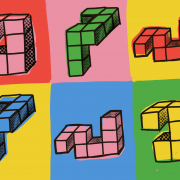Memory permits the reuse of past cognitive computations
Psychologists and neuroscientists have long studied memory using experimental tasks in which people or animals are presented with some information and then later asked to make judgments about it. This approach has led to a view of memory as a system specialized for solving these kinds of recollection tasks. Recent work by scientists at the Center for Brains, Minds, and Machines (CBMM) have suggested that memory may be much more ubiquitous, permeating many other computational systems.
To understand this alternative perspective, let's start with a simple example: addition. When children first learn addition, they rely on explicit counting. As a consequence, the time it takes them to answer an addition problem scales linearly with numerical magnitude. After extensive practice, children come to memorize addition tables, which allows them to answer addition problems rapidly, without counting. Several decades ago, the psychologist Gordon Logan suggested that this kind of shift from computation to memorization characterizes the development of automaticity across different cognitive domains. However, constructing a look-up table in memory is by itself too simplistic to explain how memory could be deployed to support complex cognitive functions like planning and probabilistic inference.
In a recent paper published in Trends in Cognitive Sciences, CBMM scientists proposed a more sophisticated version of Logan's idea, whereby memory can be flexibly combined with computation. Senior author Sam Gershman, former MIT postdoc now Harvard professor and CBMM member, completed the project with his former PhD student and lead author Dr. Ishita Dasgupta, currently a research scientist at DeepMind. In general, functions that our brains need to compute have internal structure. For example, plans can be broken down into sub-plans, and probabilities over complex events can be broken down into probabilities over sub-events. Memorizing the whole computation would be too brittle to support flexible generalization (e.g., planning a route to a new location or predicting a new event). Instead, Dasgupta and Gershman hypothesize that the brain adaptively figures out which parts of complex computations to memorize, and stores these memories in a form that can be flexibly combined.
One way to formalize this idea is using a deep neural network that is trained to solve a set of problems. The network will learn to store information from past computations that is useful for answering a wide range of queries. In an earlier collaboration with Eric Schulz (former postdoc at Harvard University, now a group leader at the Max Planck Institute of Biological Cybernetics) and Josh Tenenbaum (Professor at MIT and fellow CBMM researcher), Dasgupta and Gershman showed that this idea can be used to explain a number of enigmatic cognitive phenomena in the domain of probabilistic inference. For example, people are pretty good at reasoning about "believable" probabilities (e.g., what's the probability of a positive test result when the test accuracy is 95% and the base rate of positive tests is 1%) but not "unbelievable" probabilities (e.g., what's the probability of a positive test result when the test accuracy is 1% and the base rate of positive tests is 95%). This indicates that our brains are not equipped with a general-purpose probabilistic inference engine that can operate over arbitrary numbers. It is more consistent with a model in which our brains "learn to infer," storing and reusing past inferences rather than computing them from scratch.
Dasgupta and Gershman suggest that memory may serve as a cornerstone of intelligence in biological and artificial systems. Storing past computations is a powerful way to make future computations more efficient. This may explain why we're able to do so much so quickly despite limited computational resources at our disposal.

